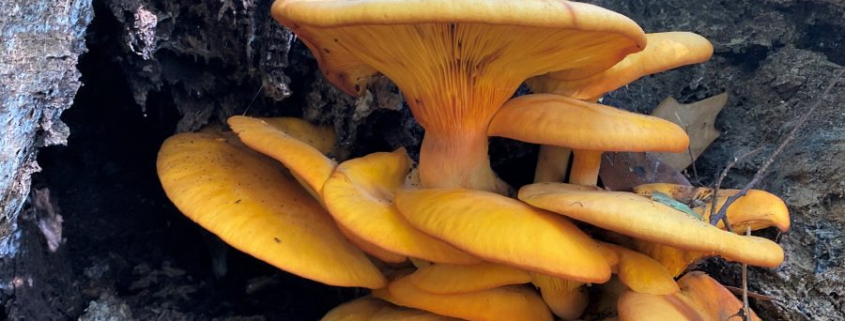A Few Fungal Highlights from an Early Fall Trek through a River Terrace Forest
As a forestry undergraduate I took courses with titles like Plant Pathology and Eastern US Forest Diseases, studying economically important tree diseases like chestnut blight, Dutch elm disease, beech-scale-nectria, white pine blister rust, fusiform rust, and oak wilt. I learned fungi as disease agents and causes of decay and wood deterioration reducing the commercial value of important timber species. I also understood the crucial role fungi played in the great cycle of life… returning dead and dying woody material to the soil. In graduate school I delved more deeply into the positive synergy between tree roots and mycorhizal fungi. Most importantly, I paid little heed to mushrooms common to the forests I roamed as a teenager, or to those I am sure I encountered during my 12 years of forestry practice in Virginia, the Carolinas, Georgia, Florida, and Alabama. Likewise, I passed through my 35 years at nine universities (seven states) nearly oblivious to the ubiquitous fungi-kingdom inhabitants in natural areas that I explored and wandered.
A Day of Visual Mushroom Bounty
But, in retirement that has changed. If you’ve followed these Posts over the past four years you will have noticed my ever-increasing fascination with fungi and their fruiting bodies. In the old days, my attention focused above-ground from tree trunks to their towering heights. I find myself these days visually scouring the ground for colorful, diverse, odd, and edible mushrooms. When I mention in these Posts that this or that species is edible, I offer a necessary caveat that the reader not take my word for it. The lion’s mane fungi (Hericium erinaceus; below) is one I harvest, prepare, and consume. Its vivid whiteness in our fall and winter woods makes it easy to spot. Its delicate filamentous structure is unique and a sensory delight to hold and examine. I found this specimen on a well-decayed downed tree October 17, 2020 in a bottomland hardwood forest on the eastern end of Alabama’s Wheeler National Wildlife Refuge. Other names for lion’s mane include: monkey head; bearded hedgehog; pom-pom; bearded tooth.
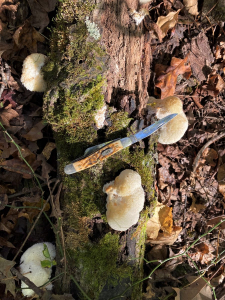
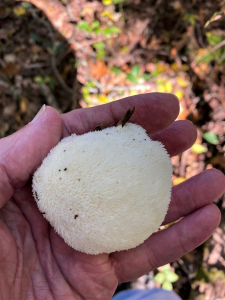
The October 17, 2020 trek offered other fungal rewards. This large willow oak (Quercus phellos) looked sound and healthy until I glanced above to about ten feet (below right), where a foot-wide cluster of shaggy bracket fungi (Inonotus hispidus) extended from the trunk. I could just reach it with my fingertip, feeling its soft pliant texture. Many other fresh brackets hung above me to 25 feet. This fungus is a decay organism, feasting upon a living tree. The old Steve-as-timber-beast would have lamented the reduction of commercial value and perhaps marked the stem for harvest. Now I marvel at the simple beauty of this shelf fungus. Its deep color and large dimensions. First-Nature.com remarks, White rot results from attack by the Shaggy Bracket, and infected trees have to be felled because this aggressive decay agent weakens the timber and can result in trunks or branches breaking and falling in stormy weather. Although still living, this oak is doomed. How long will it survive? I certainly cannot hazard a guess. Perhaps last night’s gusty winds have already felled it. Or it may continue to run its annual cycles of bud break and leaf abscission another decade…or three. The circle is in fact unbroken, even if the tree (or, shall I say, especially if and when) the tree crashes to the horizontal. The material of its cells will become soil organic matter, then will find warm absorption in a new plant…or slug or insect or small mammal or a future mighty oak and perhaps once again hang from the side of an oak within the structure of a shaggy bracket fungus.
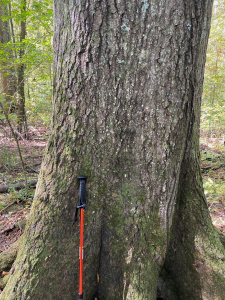
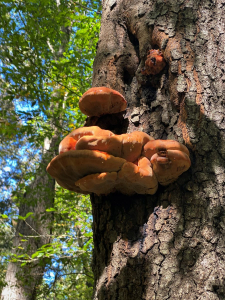
Another oak, this one dead on its stump, sprouted a colony of (Ganoderma sessile), a polypore fungus. Like all Ganoderma species, G sessile has a shiny lacquered surface, especially when fresh like this grouping.
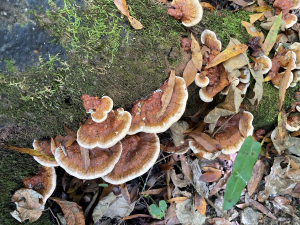
I found its distinctive beauty to0 special to include just a single photo. Enjoy all three, taken within ten feet of each other!
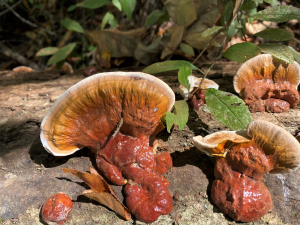
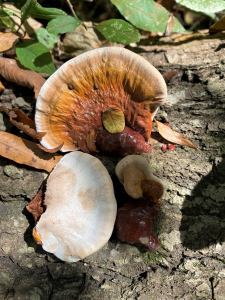
Two weeks later (November 4, 2020), I retraced my steps (more or less), coming across the same colony of G. sessile. Their lacquered sheen lies hidden beneath a thick dusting of countless spores. Nothing in Nature is static.
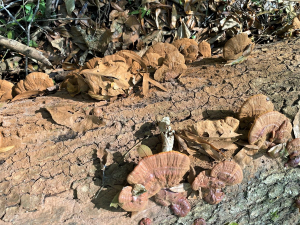
This is upright coral fungus (Ramaria stricta), common in forests across most of the US, growing on dead wood. Also known as strict-branch coral, this fungus appears throughout our local bottomland hardwood forests.
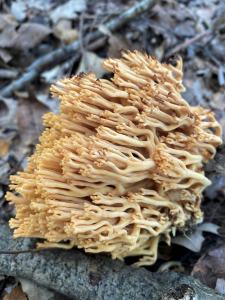
My iNaturalist app did not provide a definitive identity on these two beauties. It offered ten suggestions, most of them of the genus Amanita, which I accept, but not with certainty. The taller specimen stands about six inches. The cap and stalk are firm. The cap is scaly. Those features seem distinctive, yet I could not secure a firm identity.
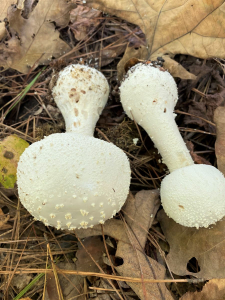
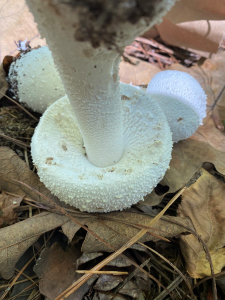
Two Days Later at Big Cove Creek Greenway
Two days later (October 19) I biked at Big Cove Creek Greenway, City of Huntsville. Here I am standing by a trail-side river birch (Betula nigra) with its exfoliating bark. I append these additional photos because the timing fell so close to my discovering the mushroom menagerie above at the Wheeler Refuge and because of the spectacular display offered by what I found along the greenway. I had grown a beard, confirming my old man of the woods look, and verifying the image of a mushroom geezer! The beard is no longer with me (I exfoliated it!), so I felt compelled to include bearded-Steve in one of these Posts.
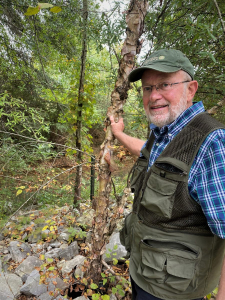
Here is the spectacular display — these eastern American jack-o’-lantern mushrooms (Omphalotus illudens) visually shouted at me as I passed them. I couldn’t resist gathering images. What better time to find these jack-o’-lanterns than the Halloween season!
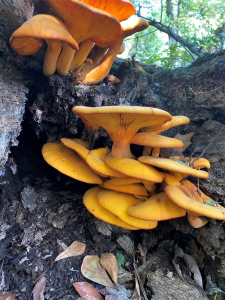
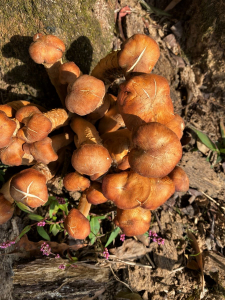
My growing interest in fungi and mushrooms enriches my forest wanderings. I’ve discovered that the more I know, the harder I look, and the more I see. What in prior years had been invisible to me is now in plain sight. And what is in plain sight generates deep feelings of respect, admiration, learning, and inspiration.
Thoughts and Reflections
I offer two observations from my mid-October fungi explorations through an aging hardwood bottomland forest:
- Nature’s gifts come in all sizes and variations, from a towering oak to the mushrooms of its decay fungi
- We can find whatever we seek when we know where to look within Nature
-
Inhale and absorb Nature’s elixir. May Nature Inspire, Inform, and Reward you!
Note: All blog post images created & photographed by Stephen B. Jones unless otherwise noted. Please circulate images with photo credit: “©2020 Steve Jones, Great Blue Heron LLC. All Rights Reserved.”
Another Note: If you came to this post via a Facebook posting or by an another route, please sign up now (no cost… no obligation) to receive my Blog Post email alerts: http://eepurl.com/cKLJdL
And a Third: I am available for Nature-Inspired Speaking, Writing, and Consulting — contact me at steve.jones.0524@gmail.com
Reminder of my Personal and Professional Purpose, Passion, and Cause
If only more of us viewed our precious environment through the filters I employ. If only my mission and vision could be multiplied untold orders of magnitude:
Mission: Employ writing and speaking to educate, inspire, and enable readers and listeners to understand, appreciate, and enjoy Nature… and accept and practice Earth Stewardship.
Vision:
- People of all ages will pay greater attention to and engage more regularly with Nature… and will accept and practice informed and responsible Earth Stewardship.
- They will see their relationship to our natural world with new eyes… and will understand more clearly their Earth home.
Tagline/Motto: Steve (Great Blue Heron) encourages and seeks a better tomorrow through Nature-Inspired Living!
Steve’s Three Books
I wrote my books Nature Based Leadership (2016), Nature-Inspired Learning and Leading (2017), and Weaned Seals and Snowy Summits: Stories of Passion for Place and Everyday Nature (2019; co-authored with Dr. Jennifer Wilhoit) to encourage all citizens to recognize and appreciate that every lesson for living, learning, serving, and leading is either written indelibly in or is powerfully inspired by Nature.
I began writing books and Posts for several reasons:
- I love hiking and exploring in Nature
- I see images I want to (and do) capture with my trusty iPhone camera
- I enjoy explaining those images — an educator at heart
- I don’t play golf!
- I actually do love writing — it’s the hobby I never needed when my career consumed me
- Judy suggested my writing is in large measure my legacy to our two kids, our five grand kids, and all the unborn generations beyond
- And finally, perhaps my books and Blogs could reach beyond family and touch a few other lives… sow some seeds for the future


All three of my books (Nature Based Leadership; Nature-Inspired Learning and Leading; Weaned Seals and Snowy Summits) present compilations of personal experiences expressing my (and co-author Dr. Wilhoit for Weaned Seals and Snowy Summits) deep passion for Nature. All three books offer observations and reflections on my relationship to the natural world… and the broader implications for society. Order any and all from your local indie bookstore, or find them on IndieBound or other online sources such as Amazon and LifeRich.

